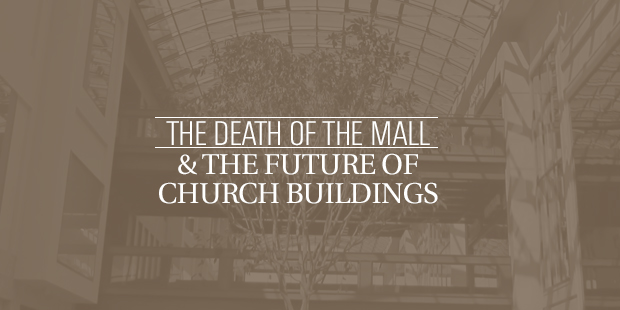
The Death of the Mall and the Future of Church Buildings
I remember the first time I went to a mall. Raised in a small town in the southeastern section of Alabama, I was amazed when I went to the “big city” mall in Montgomery. All the stores were under one roof. They were new and shiny. The venture became an adventure for me.
But that was fifty years ago. Things have changed. Things have changed significantly.
As Jeff Jordan notes in The Atlantic Cities, the future of American shopping malls is tenuous.
The Plight of the American Shopping Mall
As Jordan says in his prescient article, the trends are gloomy for malls. Sales are down. Numbers of malls have closed or they are on the precipice of closing. Vacancy rates are up. Jordan notes “there are more than 200 malls with over 250,000 square feet that have vacancy rates of 35 percent or higher, a clear marker for shopping center distress.” He further provides data that indicate over 10 percent of malls will close in the next five years.
Of course, the declaration of the death of American malls is an overstatement or, at the very least, a premature obituary. Many malls will remain open; a number will remain viable and growing. Still, the trends are unmistakable and unavoidable. Only those who deny reality will fail to note the implications of this issue.
The Relationship to Church Facilities
Is it then fair to suggest any relationship between the decline of the malls and the future of the church buildings? I think so. To be sure, most malls are adversely affected by the growth of online shopping. There are not too many brick and mortar stores that don’t feel the impact of the Internet.
But there is more to the decline of the malls than the rise of the digital world. The Boomer generation has been the generation of bigness and sprawl. Their parents, in the aftermath of World War II, moved numbers of them to the new and massive suburbia. Large malls would soon follow. Most large megachurch buildings were constructed primarily for the favor of the Boomers.
But the children of the Boomers, Generation X and, even more, the Millennials, have been pushing for more intimacy and smallness. They triggered the unprecedented growth of Starbucks. They have been the key movers in social media, which has fostered a new online intimacy.
Among the Christian Millennials there is a desire for greater intimacy in church. They are in many ways triggering a new small group revolution. And though they may not have an explicit aversion to large church facilities, neither are they attracted to them.
The Future Size of Church Facilities
As there will still be large malls twenty years from now, so will there be large church facilities whose worship centers can accommodate 2,000 or more in one service. But you will also see a discernible difference in megachurches in ten or twenty years. Fewer of these large churches will have large facilities. More will have smaller worship centers and multiple venues, many with multiple gathering times and days.
The trend in smaller facilities will not be limited to just the largest of churches. Churches of all sizes will “downsize.” Or, as an alternative, they will not build larger the first moment the capacity feels challenged in their worship services.
A Boomer church leader looks at a small building and limited acreage and sees challenges. He sees the limitations of size and space. A Millennial leader looks at the same building and acreage and sees opportunity. He immediately thinks multiple venues, multiple services, and multiple days.
It will be fascinating to watch these trends unfold. Large malls will yield to online shopping and smaller and more intimate shopping villages. And large church buildings will yield to smaller church buildings and other venues that aren’t “churchy” at all. The result may be that we will see our church facilities actually utilized more; greater facility stewardship could result. After all, only college football stadiums are utilized less than church facilities.
Read more from Thom here.

Tags: Connect, Physical space, Thom Rainer, Worship












